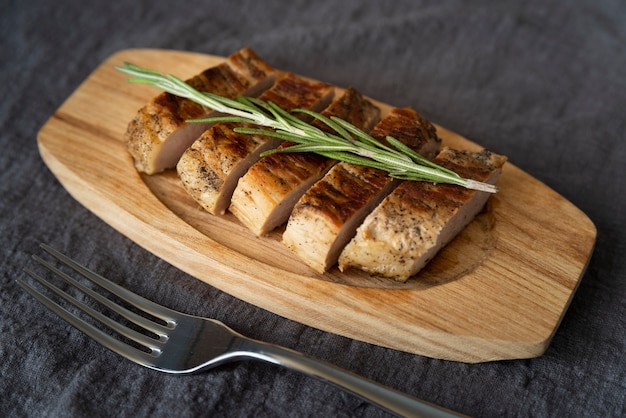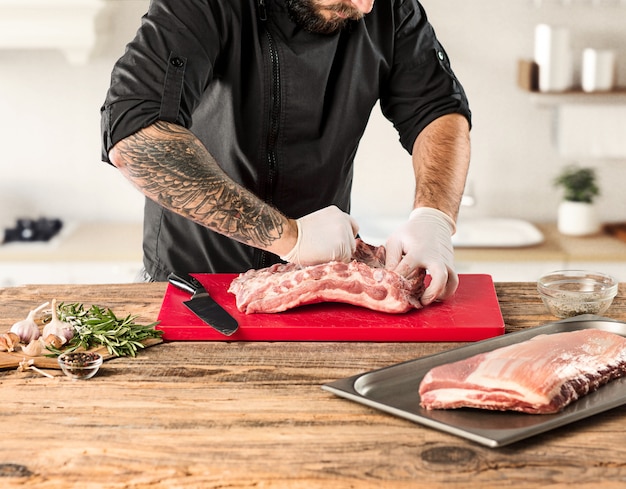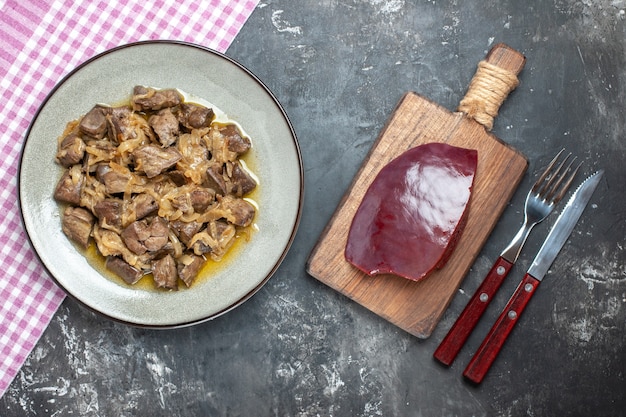Let’s face it, pork tenderloin gets a bit of a bad rap. It’s often seen as a boring, bland cut of meat. But trust me, when cooked right, pork tenderloin is a real star in the kitchen! It’s lean, versatile, and cooks up incredibly fast. It's a favourite in our house for weeknight meals, as well as special occasions. And I'm here to tell you, you don't need to be a culinary expert to whip up a delicious pork tenderloin. Whether you're a complete beginner or a seasoned chef, I'm going to guide you through everything you need to know to turn this simple cut of meat into a culinary masterpiece.
(Part 1) Choosing Your Pork Tenderloin

The first step in any great pork tenderloin journey is selecting the perfect piece. It might sound simple, but trust me, there's a bit of a science to it. You want a tenderloin that's going to cook up beautifully, and it all starts at the butcher counter.
Looking for the Right Cut
When choosing your pork tenderloin, you’re aiming for a piece that feels firm to the touch, not squishy or mushy. The colour should be a light pink, with a slight marbling. That marbling, the little streaks of fat, is crucial for flavour and tenderness. You want to avoid any tenderloins that have a strong or unpleasant smell. Honestly, it's not rocket science, but these little details make a big difference in the final outcome.
Understanding Different Cuts
You'll often see labels like "center cut" or "loin end" on pork tenderloins. The center cut, which is the middle section of the loin, tends to be the most tender and also the most expensive. While it's lovely for quick cooking methods, the loin end can be a bit tougher, making it a good choice for slow cooking methods like braising. The key thing is to trim off any excess fat before cooking. You can save those trimmings and render them down for a delicious pan sauce that will seriously elevate your dish.
Size Matters
Choosing the right size depends on how many people you're feeding. A single tenderloin usually weighs between 1 and 2 pounds. For a smaller family or a quick meal for two, one tenderloin is perfect. But if you're having a crowd over, two tenderloins might be a better option. Just remember to adjust your cooking time based on the size of the meat.
(Part 2) Preparing the Pork Tenderloin

Now that you've got your perfect piece of pork tenderloin, it’s time to prep it for cooking. This is where a little bit of prep work makes a big difference in the final flavour and texture.
Trimming the Tenderloin
The first thing you want to do is trim off any excess fat and silver skin. That silver skin, a tough, silvery membrane, can make the tenderloin chewy and unpleasant to eat. A sharp knife is your best friend here, but a good pair of kitchen shears can also come in handy. Just carefully slice it off, leaving you with a beautiful, smooth piece of meat.
Seasoning Strategies
My go-to for pork tenderloin is a simple salt and pepper rub. It allows the natural flavour of the meat to shine through. But don't be afraid to get creative! Garlic powder, paprika, oregano, rosemary, and thyme are all great additions. A bit of freshly ground black pepper adds a kick. The key is to choose a spice blend that complements your chosen cooking method.
Marinades
If you want to take things to the next level, a marinade is your best friend. Marinades not only add flavour but also help to tenderize the meat. A simple marinade of olive oil, lemon juice, and fresh herbs can be incredibly effective. You can also get fancy with citrus marinades, honey-soy glazes, or even a spicy jerk marinade. Just remember to let the tenderloin marinate for at least a few hours, or even overnight, for the best results.
(Part 3) Cooking the perfect pork tenderloin

Alright, let's get cooking! There are several great ways to cook a pork tenderloin, each resulting in a different taste and texture.
Pan-Searing
This is my personal favourite for a quick and flavourful meal. It’s simple, fast, and incredibly satisfying. Just heat a heavy-bottomed pan over medium-high heat, add a tablespoon of oil, and sear the tenderloin on all sides until it's nicely browned. This creates a beautiful crust and locks in the juices. Then, reduce the heat to medium and cook for another 5-7 minutes, or until the internal temperature reaches 145 degrees Fahrenheit (63 degrees Celsius). You’ll know it’s done when it’s no longer pink in the centre.
oven roasting
For a larger tenderloin or when you're feeding a crowd, oven roasting is the way to go. Preheat your oven to 375 degrees Fahrenheit (190 degrees Celsius). Place the tenderloin on a baking sheet and roast for 20-25 minutes, or until the internal temperature reaches 145 degrees Fahrenheit (63 degrees Celsius). For extra flavour, try adding a few sprigs of rosemary or thyme to the baking sheet.
Grilling
There's nothing quite like a smoky, grilled pork tenderloin. For this, you'll need a hot grill, preheated to medium heat. Grill the tenderloin for 15-20 minutes, turning it every 5 minutes, until the internal temperature reaches 145 degrees Fahrenheit (63 degrees Celsius). To add extra flavour, try brushing the tenderloin with a marinade or glaze during the last few minutes of grilling.
slow cooker
For an incredibly tender and juicy pork tenderloin, slow cooking is the way to go. It’s a hands-off method that results in a melt-in-your-mouth texture. Place the tenderloin in a slow cooker with a cup of broth or apple juice for extra moisture. Cook on low heat for 4-6 hours. Remember to check the internal temperature before serving. You can even add a few vegetables, such as onions, carrots, or potatoes, to the slow cooker for a complete meal.
(Part 4) Resting and Carving
Now, here's a crucial step that many people skip, but I can't stress it enough - resting. After cooking, let the pork tenderloin rest for at least 10 minutes before carving. This allows the juices to redistribute throughout the meat, ensuring a tender and juicy result. Cover the tenderloin loosely with foil to keep it warm.
Carving Techniques
When it comes to carving, a sharp knife is your best friend. Carve the tenderloin across the grain, which means cutting perpendicular to the direction of the muscle fibers. This ensures tender, juicy slices. I like to cut the tenderloin into medallions, but you can slice it into thinner pieces, depending on your preference.
(Part 5) Serving Your Pork Tenderloin
You’ve got a beautifully cooked and carved pork tenderloin. Now, it's time to think about the finishing touches - the sides and sauces that will make your dish truly special.
side dishes
Pork tenderloin is a versatile cut of meat that pairs perfectly with a wide range of side dishes. Some of my personal favourites include:
- Roasted vegetables: Asparagus, Brussels sprouts, carrots, and sweet potatoes all add vibrant flavour and texture.
- Potato dishes: mashed potatoes, roasted potatoes, or potato wedges provide a comforting and classic pairing.
- Salads: A fresh, crisp salad with a vinaigrette dressing adds lightness and balance to a hearty meal.
- Rice: Simple and versatile, rice is a classic side dish that works well with any pork tenderloin recipe.
- fruit salad: For a sweet and tangy contrast, try serving your pork tenderloin with a refreshing fruit salad.
Sauces and Dressings
A good sauce can elevate any pork tenderloin dish. I love to make a simple pan sauce by adding some butter, garlic, and white wine to the pan drippings after cooking the tenderloin. You can also create a delicious sauce by blending the pan drippings with a bit of cream and herbs. If you want something more adventurous, a fruity sauce like cranberry or a creamy mushroom sauce is always a good choice. For a lighter option, try a balsamic glaze or lemon vinaigrette.
(Part 6) Storing and Leftovers
Let’s be honest, leftover pork tenderloin is a real treat. It's perfect for lunch or dinner the next day. Just make sure to store it properly to ensure it stays fresh and safe to eat.
Storing Cooked Pork Tenderloin
Allow the cooked tenderloin to cool completely before storing it in an airtight container in the refrigerator. It should stay fresh for up to 3 days. If you want to freeze your leftovers, wrap them tightly in plastic wrap and then place them in a freezer-safe bag. It will keep well for up to 3 months.
Reheating Leftovers
You can reheat your leftover pork tenderloin in the microwave, oven, or skillet. If you’re using the microwave, heat it on low power for 1-2 minutes, or until heated through. For the oven, preheat to 350 degrees fahrenheit (175 degrees Celsius) and reheat for 10-15 minutes. And if you want to add a bit of flavour, heat a small amount of oil in a skillet over medium heat and reheat the tenderloin for 3-5 minutes, or until heated through.
(Part 7) pork tenderloin recipes
Ready to dive into some deliciousness? Here are a few of my favourite pork tenderloin recipes to get you started. These recipes are simple to follow and perfect for weeknight dinners or special occasions.
Honey Garlic Glazed Pork Tenderloin
This recipe is a crowd-pleaser, combining the sweetness of honey with the savoury punch of garlic. It's a great way to add a burst of flavour to your tenderloin.
Ingredients:
- 1 pound pork tenderloin
- 1 tablespoon olive oil
- 1/4 cup honey
- 2 tablespoons soy sauce
- 1 tablespoon minced garlic
- 1 teaspoon ground ginger
- 1/2 teaspoon black pepper
Instructions:
- Preheat your oven to 375 degrees Fahrenheit (190 degrees Celsius).
- In a small bowl, combine the honey, soy sauce, garlic, ginger, and pepper.
- Place the pork tenderloin in a baking dish and rub it with the honey-garlic mixture.
- Roast for 20-25 minutes, or until the internal temperature reaches 145 degrees Fahrenheit (63 degrees Celsius).
- Let the tenderloin rest for 10 minutes before carving and serving.
Rosemary Dijon Pork Tenderloin
This recipe features a vibrant blend of rosemary and Dijon mustard, creating a delicious, earthy flavour profile. The Dijon mustard adds a tangy kick, while the rosemary provides a lovely aroma.
Ingredients:
- 1 pound pork tenderloin
- 1 tablespoon olive oil
- 1 tablespoon Dijon mustard
- 1 tablespoon chopped fresh rosemary
- 1 teaspoon garlic powder
- 1/2 teaspoon black pepper
Instructions:
- Preheat your oven to 375 degrees Fahrenheit (190 degrees Celsius).
- In a small bowl, combine the olive oil, Dijon mustard, rosemary, garlic powder, and black pepper.
- Place the pork tenderloin in a baking dish and rub it with the rosemary-Dijon mixture.
- Roast for 20-25 minutes, or until the internal temperature reaches 145 degrees Fahrenheit (63 degrees Celsius).
- Let the tenderloin rest for 10 minutes before carving and serving.
Apple Cider Pork Tenderloin
This recipe is perfect for autumn and features the warm, sweet flavour of apple cider. It's a simple and delicious way to add a touch of sweetness to your pork tenderloin.
Ingredients:
- 1 pound pork tenderloin
- 1 tablespoon olive oil
- 1/2 cup apple cider
- 1/4 cup brown sugar
- 1 tablespoon Dijon mustard
- 1 teaspoon garlic powder
- 1/2 teaspoon black pepper
Instructions:
- Preheat your oven to 375 degrees Fahrenheit (190 degrees Celsius).
- In a small bowl, combine the apple cider, brown sugar, Dijon mustard, garlic powder, and black pepper.
- Place the pork tenderloin in a baking dish and pour the apple cider mixture over it.
- Roast for 20-25 minutes, or until the internal temperature reaches 145 degrees Fahrenheit (63 degrees Celsius).
- Let the tenderloin rest for 10 minutes before carving and serving.
(Part 8) Pork Tenderloin Variations
Don't be afraid to experiment! Pork tenderloin is incredibly versatile and lends itself to a variety of flavour combinations and cooking techniques. Here are a few ideas to inspire your culinary creativity.
Stuffed Pork Tenderloin
Stuffing your tenderloin adds a whole new dimension of flavour and texture. You can create a variety of fillings, from savory to sweet. Here are a few ideas to get you started:
- Spinach and Feta: A classic combination that's both flavourful and satisfying.
- Mushroom and Sausage: A hearty and flavourful stuffing for a comforting meal.
- Apple and Sage: A sweet and savory stuffing that's perfect for fall.
- Cranberry and Pecan: A festive stuffing that's ideal for holiday meals.
To stuff your tenderloin, make a slit down the centre of the tenderloin, but don't cut all the way through. Fill the slit with your chosen stuffing, then tie the tenderloin tightly with kitchen twine to prevent the stuffing from spilling out during cooking.
Pork Tenderloin Medallions
Cut the tenderloin into 1-inch thick medallions. These are great for quick cooking methods, like pan-frying or grilling. Serve them with a flavorful sauce or a simple salad.
Pork Tenderloin Skewers
Cut the tenderloin into 1-inch cubes and thread them onto skewers with your favourite vegetables. Peppers, onions, and zucchini are great options. Grill or pan-fry the skewers until the pork is cooked through.
(Part 9) Troubleshooting
Even the most experienced cooks can face challenges in the kitchen. Here are some common problems you might encounter when cooking pork tenderloin and how to fix them.
Dry Pork Tenderloin
If your tenderloin is dry, it’s likely because it was overcooked. To prevent this in the future, try cooking it to a lower internal temperature or use a more moist cooking method, such as slow cooking or braising. You can also add a bit of liquid to the pan during cooking, such as broth or wine, to help keep the meat moist.
Tough Pork Tenderloin
A tough tenderloin often means it was cooked at too high a temperature or for too long. To prevent this, cook the tenderloin at a lower temperature and don't overcook it. You can also use a meat thermometer to check the internal temperature and ensure it’s cooked to the desired level.
Unevenly Cooked Pork Tenderloin
If your tenderloin is unevenly cooked, it might be because it wasn't evenly thick. To ensure even cooking, try to trim the thicker areas to create a more uniform shape. You can also use a meat thermometer to check the internal temperature in several spots to ensure it's cooked through evenly.
(Part 10) FAQs
Let’s tackle some of the most common questions about cooking pork tenderloin.
1. How long should I cook a pork tenderloin?
The cooking time for a pork tenderloin will vary depending on its size, the cooking method, and the desired level of doneness. As a general rule, a 1-pound pork tenderloin should take about 20-25 minutes to cook in a 375 degrees Fahrenheit (190 degrees Celsius) oven. But always use a meat thermometer to ensure the internal temperature reaches 145 degrees Fahrenheit (63 degrees Celsius). It's the most reliable way to guarantee your pork is cooked perfectly.
2. What temperature should pork tenderloin be cooked to?
The USDA recommends cooking pork tenderloin to an internal temperature of 145 degrees Fahrenheit (63 degrees Celsius) to ensure it’s safe to eat. This temperature ensures that any harmful bacteria are killed. A meat thermometer is essential for accurate temperature readings.
3. Can I freeze pork tenderloin?
Yes, you can freeze pork tenderloin for up to 3 months. Wrap it tightly in plastic wrap and then place it in a freezer-safe bag. When you’re ready to use it, thaw the tenderloin in the refrigerator overnight. You can also thaw it in the microwave or by placing it in a bowl of cold water. Just make sure to cook the tenderloin immediately after thawing.
4. What are some good ways to serve pork tenderloin?
Pork tenderloin is a versatile cut of meat that can be served in a variety of ways. It's delicious with a simple pan sauce, a creamy mushroom sauce, or a fruity cranberry sauce. It also pairs well with roasted vegetables, potato dishes, and salads. Experiment with different flavour combinations and find what you love!
5. Can I cook pork tenderloin in a slow cooker?
Yes, you can cook pork tenderloin in a slow cooker. This is a great option if you’re looking for a tender and juicy tenderloin. Just place the tenderloin in the slow cooker with a cup of broth or apple juice and cook on low heat for 4-6 hours. You can even add a few vegetables, such as onions, carrots, or potatoes, for a complete meal.
Everyone is watching

Corn on the Cob: The Ultimate Guide to Perfectly Cooked Ears
Healthy MealsAh, corn on the cob. Just the name evokes images of sunny days, barbecues, and that sweet, juicy flavour that ...

Perfect Pork Roast Oven Cooking Time: A Guide to Delicious Results
Healthy MealsThere's something truly satisfying about a perfectly roasted pork. The aroma alone is enough to make your mout...

Ham Cooking Time: How Long to Bake, Smoke, or Boil a Delicious Ham
Healthy MealsAh, ham. It's a classic, isn't it? A real crowd-pleaser, especially around holidays. And when done right, it'...

Scallops: The Ultimate Guide to Perfect Cooking
Healthy MealsAh, scallops. Those delicate, sweet, and utterly delicious morsels of the sea. They hold a special place in my...

Spaghetti Squash: The Ultimate Guide to Cooking and Serving
Healthy MealsRemember that time you saw spaghetti squash at the supermarket, looking all bumpy and strange, and thought, "W...
